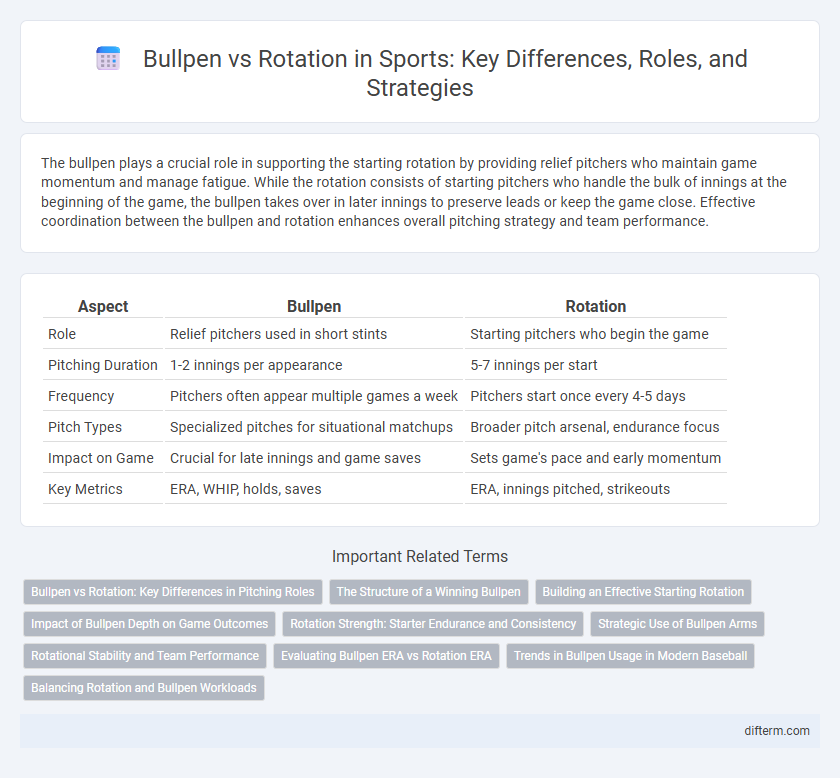The bullpen plays a crucial role in supporting the starting rotation by providing relief pitchers who maintain game momentum and manage fatigue. While the rotation consists of starting pitchers who handle the bulk of innings at the beginning of the game, the bullpen takes over in later innings to preserve leads or keep the game close. Effective coordination between the bullpen and rotation enhances overall pitching strategy and team performance.
Table of Comparison
| Aspect | Bullpen | Rotation |
|---|---|---|
| Role | Relief pitchers used in short stints | Starting pitchers who begin the game |
| Pitching Duration | 1-2 innings per appearance | 5-7 innings per start |
| Frequency | Pitchers often appear multiple games a week | Pitchers start once every 4-5 days |
| Pitch Types | Specialized pitches for situational matchups | Broader pitch arsenal, endurance focus |
| Impact on Game | Crucial for late innings and game saves | Sets game's pace and early momentum |
| Key Metrics | ERA, WHIP, holds, saves | ERA, innings pitched, strikeouts |
Bullpen vs Rotation: Key Differences in Pitching Roles
The bullpen and rotation serve distinct yet complementary pitching roles in baseball, with starters in the rotation typically throwing multiple innings per game to set the tone, while bullpen pitchers specialize in shorter, high-leverage appearances. Rotation pitchers focus on endurance and pacing to face opposing lineups multiple times, whereas bullpen pitchers provide strategic relief, often as closers or setup men, to preserve leads or halt momentum shifts. Understanding bullpen vs. rotation dynamics enhances team strategy by optimizing pitcher usage based on skill sets and game situations.
The Structure of a Winning Bullpen
A winning bullpen is designed with specialized relievers who excel in high-leverage situations, including setup men and closers adept at shutting down late innings. Effective bullpens maintain a balance between long relievers for extended innings and situational pitchers skilled at facing certain batters, maximizing strategic matchup advantages. This structure ensures consistent bullpen performance reduces pressure on the starting rotation, preserving arms and elevating overall team success.
Building an Effective Starting Rotation
Building an effective starting rotation requires a strategic balance of durability, velocity, and pitch variety to maximize innings and limit opposing lineups' adjustments. Prioritizing reliable arms with strong spin rates and command metrics enhances the rotation's overall efficiency and reduces bullpen strain. Leveraging advanced analytics to monitor workload and optimize rest schedules ensures sustained performance and injury prevention throughout the season.
Impact of Bullpen Depth on Game Outcomes
Bullpen depth significantly influences game outcomes by providing strategic flexibility and maintaining pitching effectiveness in late innings, especially during high-pressure situations. Teams with robust bullpens can mitigate starter fatigue and counter opponents' adjustments, often leading to improved win probabilities. Advanced metrics consistently show that deeper bullpens correlate with lower opponent batting averages and higher saved-run percentages, underscoring their critical role in championship-caliber teams.
Rotation Strength: Starter Endurance and Consistency
Rotation strength hinges on starter endurance and consistency, ensuring pitchers can maintain velocity and control deep into games. Reliable starters reduce bullpen strain by consistently delivering quality innings, preserving relievers for high-leverage situations. High endurance starters also contribute to overall team stability by setting the pace and rhythm throughout the season.
Strategic Use of Bullpen Arms
Strategic use of bullpen arms allows managers to maximize pitcher effectiveness by matching specific pitchers to favorable in-game situations, enhancing run prevention. Bullpen specialists like setup men and closers are deployed in high-leverage innings to maintain leads, while long relievers can bridge gaps when starters exit early. Optimizing bullpen usage improves team flexibility, preserves starting rotation health, and adapts to opponent lineup tendencies.
Rotational Stability and Team Performance
Rotational stability in baseball significantly enhances team performance by ensuring consistent, high-quality pitching throughout the season. A strong starting rotation reduces reliance on the bullpen, maintaining pitcher effectiveness and minimizing fatigue-related injuries. Teams with stable rotations typically demonstrate better win-loss records and playoff success due to sustained pitching reliability.
Evaluating Bullpen ERA vs Rotation ERA
Evaluating bullpen ERA versus rotation ERA reveals crucial insights into a baseball team's pitching effectiveness, with bullpen ERA often higher due to relievers facing high-leverage situations. Rotation ERA provides a baseline for starting pitchers who cover more innings per game, affecting overall team performance and stamina management. Analyzing both metrics helps coaches allocate workload strategically and optimize game outcomes by balancing starting durability against reliever specialization.
Trends in Bullpen Usage in Modern Baseball
Recent trends in modern baseball highlight an increased reliance on bullpens, with teams employing specialized relievers to manage high-leverage situations and preserve starting pitchers' arms. Data shows a growing emphasis on limiting starters to six or seven innings, leading to more frequent pitching changes and the expanded use of multiple relievers per game. This shift reflects a strategic focus on maximizing pitcher effectiveness and adapting to advanced analytics, which prioritize matchup advantages and pitch count management.
Balancing Rotation and Bullpen Workloads
Balancing rotation and bullpen workloads is crucial for maximizing pitching efficiency and preventing injuries in baseball. Effective management involves monitoring pitch counts, ensuring starters throw deep into games while relievers maintain readiness for high-leverage situations. Teams leveraging analytics optimize rest days and matchups, enhancing overall staff durability and performance throughout the season.
bullpen vs rotation Infographic

 difterm.com
difterm.com